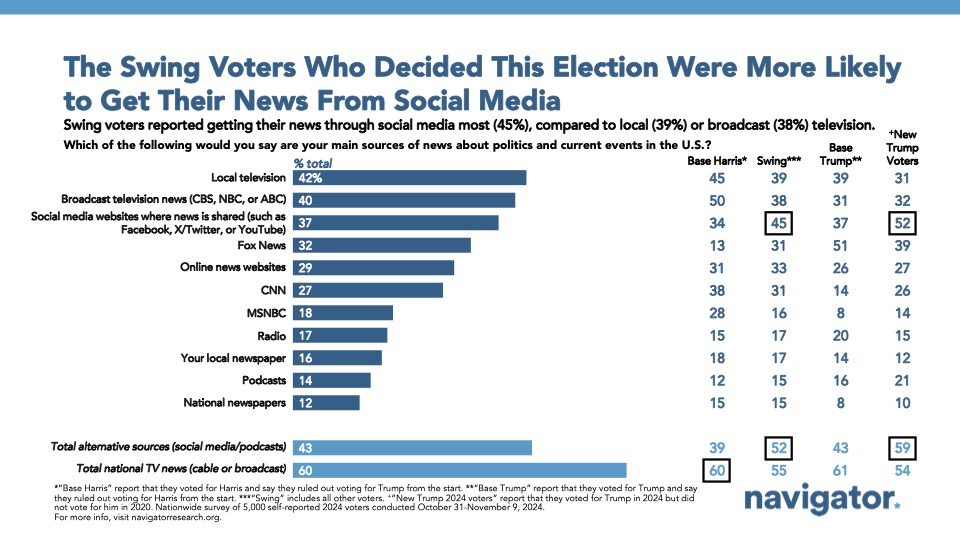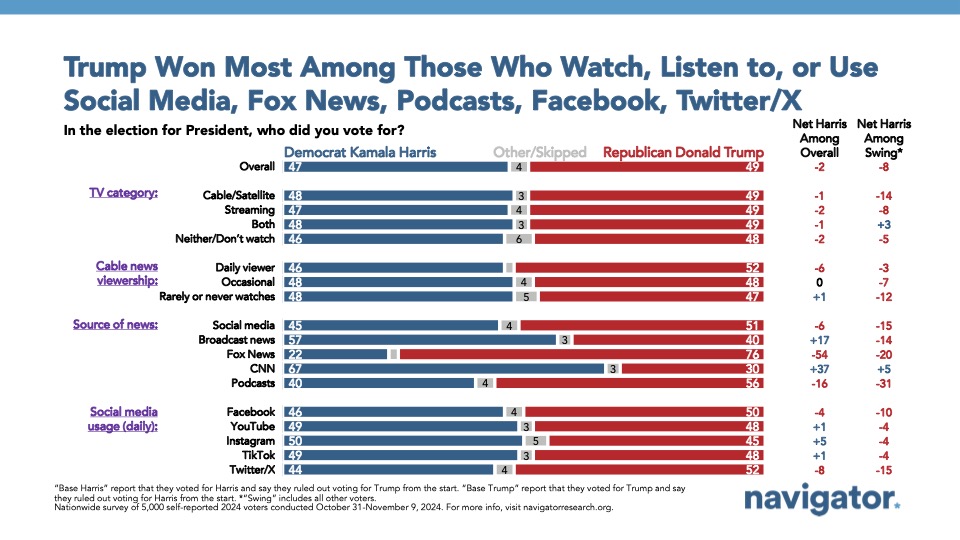Exit Poll: News Sources & Social Media
This Navigator Research report is the third in a series of releases of findings from our post-election survey among 5,000 self-reported 2024 general election voters. This release focuses on the 2024 election media environment, including what news sources the electorate was most likely to use, how voters viewed live television ads, and what social media platforms were most popular among “swing voters” and the overall electorate.
Trump voters and “swing voters” largely got their news from social media and alternative sources like podcasts.
“Swing voters” — defined here as those who did not rule out voting for Donald Trump or Kamala Harris from the start of the campaign — largely got their news from social media. Leading up to the election, 45 percent of “swing voters” and 52 percent of new Trump voters cited getting their news through social media, a far greater share than the national electorate (37 percent). Television news was much less popular with “swing voters” and Trump voters, with only 38 percent of “swing voters” and 31 percent of base Trump voters citing using broadcast television as their news source; fully half of base Harris voters got their news from broadcast television (50 percent). However, Trump voters were most likely to regularly watch a cable news channel, with 52 percent regularly watching Fox News. Base Harris voters were most likely to watch CNN (39 percent).
- Alternative news sources like social media and podcasts were much more prevalent among “swing voters” (52 percent) and new Trump voters (59 percent) compared to the overall electorate (43 percent). One in five new Trump voters said podcasts alone were a main news source (21 percent) compared to just 12 percent of base Harris voters and 14 percent of the overall electorate.
- 61 percent of “swing voters” said they watch live TV through a television internet streaming service while only 42 percent said the same for cable and satellite television.
Trump won his biggest margins among those who reported watching Fox News, listening to podcasts, using Facebook, and using Twitter/X.
Trump led among those getting their news from social media and podcasts, with Facebook being their most frequented social media platform. Those who say they use social media as their main news source voted for Trump over Harris by 6 points (51 percent Trump – 45 percent Harris). Similarly, those who used podcasts as their main news source voted for Trump by a 16-point margin (56 percent Trump – 40 percent Harris), while Harris won by 17 points among those watching broadcast news (57 percent Harris – 40 percent Trump). Among “swing voters” and base Trump voters, the most popular social media platforms for daily usage were Facebook (80 percent “swing voters,” 81 percent of base Trump voters) and YouTube (75 percent of “swing voters,” 69 percent of base Trump voters).
- Among those reporting daily usage of Twitter/X, 52 percent reported voting for Trump, while 44 percent reported voting for Harris. Similarly, daily Facebook users leaned towards Trump by a 4-point margin (50 percent Trump – 46 percent Harris) and daily Instagram users leaned towards Harris by a 5-point margin (50 percent Harris – 45 percent Trump).
About The Study
Global Strategy Group conducted an online survey of 5,000 registered voters from October 31st through November 9th, 2024, with respondents recruited from opt-in online panel vendors. Of that 5,000, 4,784 respondents were verified against a voter file (and the other 216 were voters who said they were registering before voting if interviewed before Election Day) and special care was taken to ensure the demographic composition of the sample reflected that of the expected 2024 electorate. The vote shares for Kamala Harris, Donald Trump, House and Senate Democrats, and House and Senate Republicans were also adjusted to reflect a preliminary estimate of the vote in the 2024 election. The margin of error for the full sample at the 95 percent level of confidence is +/- 1.4 percentage points. The margin of error for subgroups varies and is higher.









